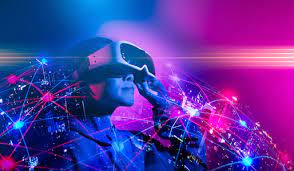The Future of Augmented Reality: Predictions for the Next Decade
Augmented Reality (AR) has come a long way since its inception, and it continues to evolve at a rapid pace. As technology advances and new applications for AR are discovered, the future of AR looks bright. In this article, we explore the predictions for the future of AR over the next decade and how it will impact various industries.
AR in Retail
AR has the potential to revolutionize the retail industry by creating immersive and interactive shopping experiences that engage customers and provide them with a more personalized experience. In the next decade, AR will become more prevalent in retail, with virtual try-on experiences becoming more sophisticated and realistic. AR will also be used to create interactive displays that provide customers with additional information about products and recommend personalized products based on their preferences.
AR in Education
AR has the potential to transform the way we learn by creating interactive and immersive learning experiences. In the next decade, AR will be used to create virtual classrooms and training environments that allow students to interact with digital objects and learn in a more engaging and interactive way. AR will also be used to create educational games and simulations that can help students learn complex subjects in a more intuitive way.
AR in Healthcare
AR has the potential to transform the healthcare industry by providing doctors and nurses with real-time information and insights. In the next decade, AR will be used to create interactive medical records that can be accessed in real-time, allowing doctors to make more informed decisions about patient care. AR will also be used to create virtual training environments that allow medical professionals to practice procedures and surgeries in a safe and controlled environment.
AR in Entertainment
AR has the potential to create new forms of entertainment by creating immersive and interactive experiences. In the next decade, AR will be used to create new forms of gaming and entertainment that blur the line between the physical and digital worlds. AR will also be used to create interactive experiences for live events, such as concerts and sports events, allowing viewers to interact with the content in real-time.
AR in Manufacturing
AR has the potential to transform the manufacturing industry by providing workers with real-time information and insights. In the next decade, AR will be used to create interactive training environments that allow workers to learn complex procedures and processes in a more intuitive way. AR will also be used to create virtual assembly lines and production environments that allow workers to visualize and optimize production processes in real-time.

The Challenges of AR in the Next Decade
While AR presents many opportunities over the next decade, it also presents several challenges, including:
Technical Complexity: AR requires specialized technical expertise, which can be difficult for some industries to acquire.
Privacy: AR can raise privacy concerns, particularly if it involves collecting and using personal data.
Integration: AR requires integration with existing systems and processes, which can be challenging for some industries.
Adoption: AR requires investment in new technology and processes, which may be a barrier to adoption for some industries.
Skills Gap: AR requires employees with specialized skills, which may be difficult for some industries to acquire.
Conclusion
AR has come a long way since its inception, and it continues to evolve at a rapid pace. In the next decade, AR will be used in a variety of industries to create immersive and interactive experiences that engage customers and provide workers with real-time information and insights. While it presents both challenges and opportunities, it is clear that AR will play an increasingly important role in shaping the future of various industries. By investing in technical expertise and resources, ensuring that AR is used in a responsible and transparent way, and focusing on the customer and worker experience, industries can successfully leverage AR to drive growth and innovation.
One of the keys to successfully implementing AR over the next decade is to focus on the user experience. AR should be used to enhance experiences and make them more immersive, rather than to replace them. For example, in retail, AR should be used to create virtual try-on experiences that are easy to use and provide customers with accurate representations of how products would look on them. Similarly, in healthcare, AR should be used to provide doctors and nurses with real-time information that is easy to access and use, rather than creating more complexity.
Moreover, industries must ensure that they have the technical expertise and resources needed to implement AR effectively. This may involve partnering with technology companies or hiring specialized staff with expertise in AR.

Industries must also consider the privacy implications of using AR. They should be transparent about how user data is collected and used, and should ensure that user data is protected and used in a responsible way.
Another important consideration when implementing AR over the next decade is the need for integration with existing systems and processes. AR should be integrated with existing systems and processes to ensure that they can be used effectively.
AR has the potential to transform various industries by creating immersive and interactive experiences for users. While it presents both challenges and opportunities, it is clear that AR will play an increasingly important role in shaping the future of these industries. By focusing on the user experience, investing in technical expertise and resources, and ensuring that AR is used in a responsible and transparent way, industries can successfully leverage AR to drive growth and innovation over the next decade.
As the use of AR becomes more widespread, it is likely that we will see the development of new AR-specific professions and job roles. For example, we may see the emergence of AR experience designers and developers, who specialize in creating immersive and interactive AR experiences. Similarly, we may see the emergence of AR data analysts, who specialize in analyzing data generated by AR experiences to gain insights into user behaviour and preferences.
Moreover, the development of AR over the next decade will likely lead to the creation of new AR technologies and devices. For example, we may see the development of AR contact lenses or glasses, which could provide even more immersive and seamless AR experiences.
It is also likely that we will see increased collaboration between industries to develop AR applications that can be used across different sectors. For example, the healthcare and manufacturing industries could collaborate to develop AR applications that provide real-time information and insights to medical professionals during surgeries and other medical procedures.
The future of AR over the next decade looks promising, with the potential to transform various industries and create new opportunities for users and professionals alike. By investing in technical expertise and resources, ensuring that AR is used in a responsible and transparent way, and focusing on user experience, industries can successfully leverage AR to drive growth and innovation over the next decade and beyond.















